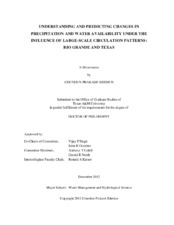| dc.description.abstract | Large-scale circulation patterns have a significant modulating influence on local hydro-meteorological variables, and consequently on water availability. An understanding of the influence of these patterns on the hydrological cycle, and the ability to timely predict their impacts, is crucial for water resources planning and management. This dissertation focusses on the influence of two major large-scale circulation patterns, the El Niño Southern Oscillation (ENSO) and the Pacific Decadal Oscillation (PDO), on the Rio Grande basin and the state of Texas, US. Both study areas are subject to a varying climate, and are extremely vulnerable to droughts, which can have devastating socio-economic impacts.
The strength and spatial correlation structure of the climate indices on gauged precipitation was first established. Precipitation is not linearly related to water availability; therefore a land surface model (LSM), with land use land cover constant, was used to create naturalized flow, as it incorporates all necessary hydro-meteorological factors. As not all ENSO events are created equal, the influence of individual El Niño and La Niña events, classified using four different metrics, on water availability was examined. A general increase (decrease) in runoff during El Niños (La Niñas) was noted, but some individual events actually caused a decrease (increase) in water availability. Long duration El Niños have more influence on water availability than short duration high intensity events. Positive PDO enhances the effect of El Niño, and dampens the negative effect of La Niña, but when it is in its neutral or transition phase, La Niña tends to dominate climatic conditions and reduce water availability.
LSM derived runoffs were converted into 3-month Standardized Runoff Indices (SRI 3) from which water deficit durations and severities were extracted. Conditional probability models of duration and severity were developed and compared with that based on observed precipitations. It was found that model derived information can be used in regions having limited ground observation data, or can be used in tandem with observation driven conditional probabilities for more efficient water resources planning and management.
Finally a multidimensional model was developed, using copulas, to predict precipitation based on the phase of ENSO and PDO. A bivariate model, with ENSO and precipitation, was compared to a trivariate model, which incorporates PDO, and it was found that information on the state of PDO is important for efficient precipitation predictions. | en |


